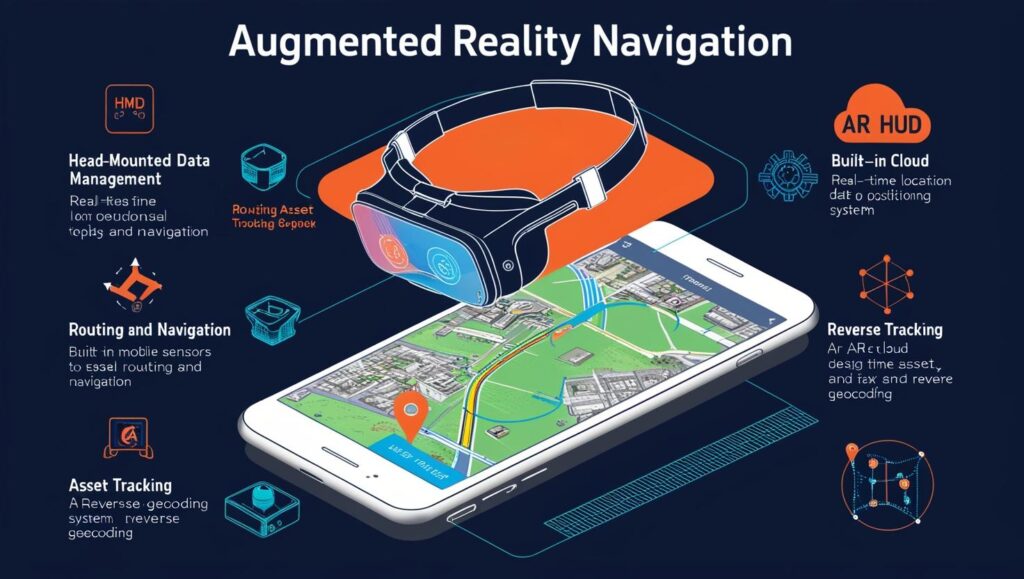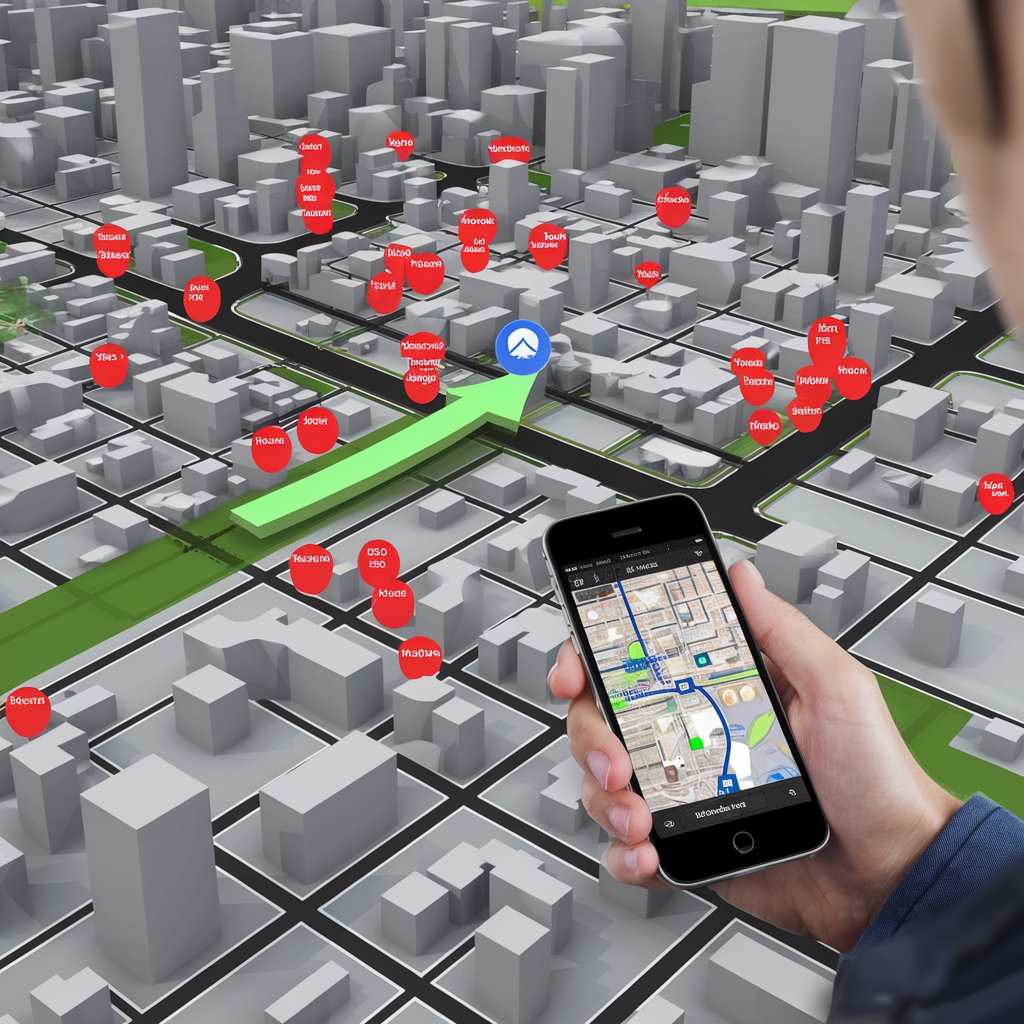Augmented Reality (AR) is no longer a futuristic concept—it’s here, transforming how we interact with the world around us. In the realm of navigation, AR is revolutionizing user experience and mobility, offering an innovative way to navigate both in urban environments and on the open road. In North America, the Augmented Reality Navigation Market is gaining momentum, thanks to the convergence of cutting-edge technologies like 5G, advanced GPS systems, and powerful mobile devices. This growth is driven by the demand for smarter, more efficient, and engaging navigation solutions in sectors ranging from transportation to tourism.
As North America continues to embrace the power of AR in navigation, it is reshaping how people travel, navigate, and explore their surroundings. Let’s dive deeper into the key drivers, applications, and future prospects of AR navigation in North America.

What is Augmented Reality Navigation?
Augmented Reality (AR) Navigation is a technology that overlays real-time, digital information—such as directions, landmarks, and points of interest—onto a user’s view of the physical world. Unlike traditional navigation systems that only provide text-based or 2D map-based directions, AR navigation uses the camera of a device (such as a smartphone, tablet, or AR glasses) to superimpose directional arrows, visual cues, or even 3D models over the real world in real-time.
The augmented reality (AR) navigation market is expected to reach USD 6.33 billion by 2029 from USD 1.17 billion in 2024, at a CAGR of 40.3% during the 2024-2029 period.
Key components of AR navigation systems include:
Real-time data processing: Combining GPS and sensor data with live visual feeds.
Interactive overlays: Directions, hazards, and points of interest displayed directly on the screen, guiding users through their environment.
Enhanced user interface: The visual elements are designed to be intuitive and user-friendly, offering a seamless experience.
The integration of AR into navigation systems not only improves how we navigate spaces but also enhances engagement and makes navigation more intuitive, efficient, and interactive.
Key Drivers of Growth in North America’s AR Navigation Market
The augmented reality navigation market in North America is growing rapidly, driven by several factors that include technological advancements, increasing demand for immersive user experiences, and the need for smarter mobility solutions.
1. Advancements in Augmented Reality Technology
Technological advancements in AR hardware and software are enabling the development of more sophisticated and immersive navigation systems. With innovations in mobile processors, sensors, and camera technologies, AR navigation systems are becoming more accurate and reliable, offering a higher quality user experience. The development of AR glasses and other wearables also promises to make AR navigation even more immersive by allowing hands-free, heads-up directions.
2. Increased Adoption of Smart Mobility Solutions
The growing demand for smart mobility solutions—such as ride-sharing, autonomous vehicles, and electric scooters—has created a significant market for advanced navigation systems. AR navigation offers a natural fit for these smart technologies, enhancing their usability and efficiency. In particular, autonomous vehicles (AVs) benefit greatly from AR, as the technology can provide real-time information about the vehicle’s surroundings, traffic conditions, and routes, all essential for safe autonomous driving.
3. Integration of 5G Connectivity
The rollout of 5G networks across North America has significantly boosted the AR navigation market. 5G connectivity enables faster data transfer and lower latency, which are critical for real-time AR applications. As 5G becomes more widespread, AR navigation systems can process and deliver high-definition, real-time data to users with minimal delays, enhancing the accuracy and responsiveness of the navigation experience.
4. Growing Demand for Enhanced User Experience
Consumers are increasingly looking for more interactive and immersive experiences in all aspects of their lives. Traditional navigation systems, while effective, are becoming outdated in the face of AR’s ability to create engaging, user-friendly, and personalized experiences. By offering intuitive visual cues and integrating dynamic, context-aware navigation features, AR enhances the overall travel experience, making it easier for people to find their way and explore new places.
5. Urbanization and Smart Cities
As North America’s cities continue to grow and urbanize, there is an increasing need for smarter solutions to manage transportation and navigation. AR can play a crucial role in improving urban mobility by offering real-time navigation to help individuals navigate dense city streets, public transport networks, or even indoor spaces such as shopping malls, airports, or hospitals. The adoption of smart city initiatives in cities like New York, Los Angeles, and Toronto further supports the growth of AR navigation by integrating smart infrastructure with navigation tools to create seamless and efficient travel experiences.
Download PDF Brochure @
https://www.marketsandmarkets.com/pdfdownloadNew.asp?id=150009689

Key Applications of AR Navigation in North America
The North American AR navigation market is expanding across several industries, each leveraging the technology to improve user experience, enhance mobility, and streamline operations. Let’s explore some of the prominent applications:
1. Automotive Industry
The automotive industry is one of the largest adopters of AR navigation technology. By integrating AR into in-car navigation systems, automotive manufacturers are providing drivers with more intuitive and interactive driving experiences. Instead of relying solely on traditional 2D maps or text-based directions, AR navigation overlays helpful information, such as turn-by-turn directions, points of interest, and hazard alerts directly onto the car’s windshield or a head-up display.
In the case of autonomous vehicles, AR navigation plays an even more critical role. The system can provide real-time information about road conditions, pedestrian movement, traffic signals, and more—helping autonomous systems make informed decisions.
2. Public Transportation
AR navigation systems are revolutionizing how passengers use public transport. In cities like New York and Toronto, AR apps guide commuters by overlaying directions, bus or subway routes, and estimated travel times on the real-world view of bus stops or stations. This makes it easier for passengers to identify their routes and reduce waiting times.
Moreover, AR navigation offers wayfinding solutions within complex transportation hubs like airports or train stations, ensuring travelers can find their way efficiently without confusion.
3. Tourism and Retail
In the tourism and retail sectors, AR navigation is providing immersive ways to explore new locations. Tourists visiting cities like San Francisco or Montreal can use AR-powered apps to receive real-time information about landmarks, historical sites, restaurants, and other points of interest, all visually displayed in their surroundings. This allows tourists to have an interactive and informative experience as they explore.
Retailers are also leveraging AR to improve the customer experience by providing in-store navigation. For example, large retail stores or shopping malls can use AR apps to guide customers to specific products, promotions, or services, enhancing both the shopping experience and operational efficiency.
4. Indoor Navigation
AR navigation has gained significant traction in indoor environments, where GPS signals are typically weak. Large venues like airports, shopping malls, museums, and hospitals are using AR to help visitors navigate their way inside these complex buildings. By simply pointing their smartphones or AR glasses at their surroundings, users can receive accurate, real-time directions to their desired destinations, eliminating the frustration of getting lost in unfamiliar spaces.
Challenges and Opportunities in the AR Navigation Market
While the AR navigation market in North America holds vast potential, there are several challenges that need to be addressed:
Challenges:
Hardware Limitations: The performance and accuracy of AR navigation are dependent on the devices used, which can vary in quality and capabilities. AR glasses and wearables, while promising, are still in the early stages of development and may face adoption hurdles due to cost or user comfort.
Privacy Concerns: AR navigation systems often collect vast amounts of real-time data about users’ locations, preferences, and activities. Ensuring that this data is secure and used responsibly will be critical for maintaining user trust.
Infrastructure Integration: For AR navigation to reach its full potential, there needs to be widespread integration with urban infrastructure, including traffic management systems, smart city initiatives, and transportation networks.
Opportunities:
Advancements in AR Wearables: As AR glasses and headsets become more advanced and affordable, there will be a significant opportunity for AR navigation to become even more immersive, hands-free, and widely adopted.
5G and Edge Computing: The advent of 5G networks and edge computing will enable faster, more reliable AR navigation experiences, allowing for real-time data processing and quicker decision-making.
Smart Cities and Urban Mobility: With increasing investments in smart cities, there will be more opportunities for AR navigation to seamlessly integrate into urban mobility solutions, improving traffic flow, public transportation, and pedestrian navigation.
The North America Augmented Reality Navigation Market is poised for tremendous growth, driven by advancements in technology, the rise of smart mobility solutions, and the increasing demand for more immersive, user-friendly experiences. Whether it’s in cars, public transportation, retail, or tourism, AR navigation is fundamentally transforming the way people move through and experience their environments. As technology continues to evolve, the future of AR navigation in North America promises even more intelligent, seamless, and connected travel experiences for users across the region.
About MarketsandMarkets™
MarketsandMarkets™ is a blue ocean alternative in growth consulting and program management, leveraging a man-machine offering to drive supernormal growth for progressive organizations in the B2B space. We have the widest lens on emerging technologies, making us proficient in co-creating supernormal growth for clients.
The B2B economy is witnessing the emergence of $25 trillion of new revenue streams that are substituting existing revenue streams in this decade alone. We work with clients on growth programs, helping them monetize this $25 trillion opportunity through our service lines – TAM Expansion, Go-to-Market (GTM) Strategy to Execution, Market Share Gain, Account Enablement, and Thought Leadership Marketing.
Built on the ’GIVE Growth’ principle, we work with several Forbes Global 2000 B2B companies – helping them stay relevant in a disruptive ecosystem. Our insights and strategies are molded by our industry experts, cutting-edge AI-powered Market Intelligence Cloud, and years of research. The KnowledgeStore™ (our Market Intelligence Cloud) integrates our research, facilitates an analysis of interconnections through a set of applications, helping clients look at the entire ecosystem and understand the revenue shifts happening in their industry.
To find out more, visit www.MarketsandMarkets™.com or follow us on Twitter, LinkedIn and Facebook.
Contact:
Mr. Rohan Salgarkar
MarketsandMarkets™ INC.
1615 South Congress Ave.
Suite 103
Delray Beach, FL 33445
USA : 1-888-600-6441